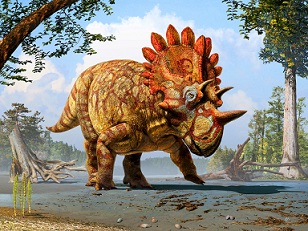
Regaliceratops Dinosaur , often dubbed the Hellboy dinosaur due to its impressive, crown-like horns resembling the comic book character's signature horns, is a remarkable ceratopsian dinosaur that lived during the Late Cretaceous period. This dinosaur, scientifically known as Regaliceratops peterhewsi, offers a fascinating glimpse into the world of horned dinosaurs and the rich prehistoric biodiversity of North America. In this exploration, we delve deep into the world of Regaliceratops, uncovering its distinctive features, habitat, discovery, and its significance in the annals of paleontology.
Regaliceratops was a member of the ceratopsian family, characterized by their elaborate frills and formidable facial horns. What sets Regaliceratops apart are its unique horns. It featured a large, crown-like frill ornamented with a central horn on the nose, similar to other ceratopsians like Triceratops. However, it sported a pair of remarkably long, curved, and forward-facing brow horns that make it instantly recognizable.
The striking feature of Regaliceratops is its massive, pentagonal frill, which extended behind its head and displayed intricate patterns of large, bony nodes. These features were likely used in intraspecific competition or communication, adding to the dinosaur's charismatic appearance
| Name: | Regaliceratops dinosaurs |
| Size: | Around 5 meters (16 feet) in length and weighed around 1.5 to 2 tons. |
| Main Facts: | Regaliceratops is known for its forward-facing brow horns, distinctive pentagonal frill, challenging previous notions about ceratopsian diversity. |
Regaliceratops was a substantial herbivorous dinosaur, with an estimated length of approximately 5 meters (16 feet) and a weight of around 1.5 to 2 tons. It likely grazed on the lush vegetation of its Late Cretaceous habitat, which consisted of ferns, cycads, conifers, and other prehistoric plants.

Fossils of Regaliceratops have been discovered in Alberta, Canada, specifically in the Dinosaur Park Formation. This region was once part of a vast, coastal floodplain, which was home to diverse dinosaur species, including other ceratopsians and large theropods like Tyrannosaurus rex.
The discovery of Regaliceratops dates back to 2005 when a fossilized skull was unearthed by a team of paleontologists led by Dr. Caleb Brown. This well-preserved skull, initially nicknamed Hellboy due to its striking appearance, was meticulously studied and later formally described as a new species in 2015.
Regaliceratops belongs to the chasmosaurine group of ceratopsid dinosaurs, closely related to other horned dinosaurs like Triceratops. Its unique combination of features, particularly its forward-facing brow horns and pentagonal frill, warranted the creation of a new genus and species.
While the behavior of Regaliceratops remains speculative, it is generally believed to have exhibited some social behaviors seen in other ceratopsians. These dinosaurs were likely social animals, possibly forming herds for protection against predators and aiding in foraging for vegetation.
Regaliceratops is significant in paleontology for several reasons. Its unique cranial features, particularly the distinctive brow horns, challenge previous notions about the diversity of horned dinosaurs in the Late Cretaceous of North America. It also provides insights into the evolution of horned dinosaur ornamentation and the selective pressures that drove the development of such features.
Regaliceratops, the Hellboy dinosaur, was a Late Cretaceous ceratopsian characterized by its striking brow horns, large pentagonal frill adorned with bony nodes, and a nose horn. It measured about 5 meters (16 feet) in length and weighed around 1.5 to 2 tons. This herbivorous dinosaur grazed on the prehistoric flora of Alberta, Canada.
Discovered in 2005, its unique combination of cranial features challenged previous notions about horned dinosaur diversity. Regaliceratops belonged to the chasmosaurine subgroup of ceratopsid dinosaurs, showcasing its distinctiveness within this family. Its fossils continue to provide insights into ceratopsian evolution and the dynamic ecosystems of the Late Cretaceous.
Comparing Regaliceratops to other dinosaurs, particularly ceratopsians, reveals both its unique features and its place within the broader context of horned dinosaurs :
Regaliceratops stands out due to its forward-facing brow horns, unlike the more common upward-curving horns seen in other ceratopsians like Triceratops. This distinctive feature likely served a different purpose in intraspecific interactions or defense.
While Regaliceratops boasted a massive, pentagonal frill adorned with bony nodes, its frill shape and ornamentation were unique among ceratopsians. Others, like Triceratops, had different frill shapes and patterns, possibly indicating species-specific display or recognition.
Regaliceratops fossils have been found in Alberta, Canada, indicating its presence in a region that was also inhabited by various other ceratopsians and large theropods during the Late Cretaceous. Each species had its specific ecological niche and adaptations.
Regaliceratops is classified within the chasmosaurine group of ceratopsid dinosaurs, a subgroup that includes Triceratops. Its distinctive features led to the establishment of a new genus and species within this group, highlighting its uniqueness.
Like other ceratopsians, Regaliceratops may have exhibited social behaviors, such as herding, foraging, and possibly displaying its cranial features during intraspecific interactions or mate selection. These behaviors were shared among many ceratopsian species.
Regaliceratops contributes to our understanding of ceratopsian evolution, particularly the diversification of horn shapes and ornamentation in Late Cretaceous North America. Its unique features challenge our preconceptions and highlight the complexity of this group.